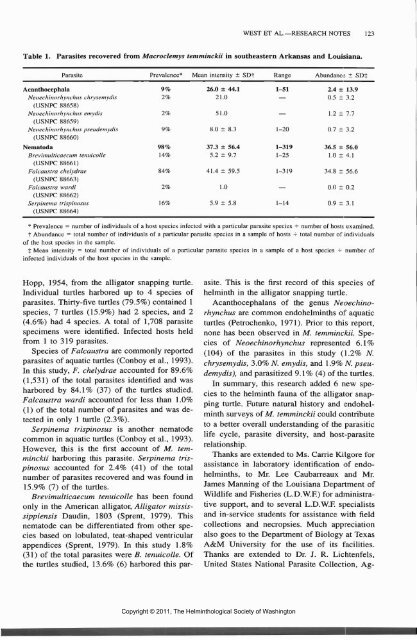Comparative Parasitology 67(1) 2000 - Peru State College
Comparative Parasitology 67(1) 2000 - Peru State College
Comparative Parasitology 67(1) 2000 - Peru State College
Create successful ePaper yourself
Turn your PDF publications into a flip-book with our unique Google optimized e-Paper software.
WEST ET AL.—RESEARCH NOTES 123<br />
Table 1. Parasites recovered from Macroclemys temminckii in southeastern Arkansas and Louisiana.<br />
Parasite Prevalence* Mean intensity ± SDf Range Abundance ± SDi<br />
Acanthocephala<br />
Neoechinarhynchus chrysemydis<br />
(USNPC 88658)<br />
Neoechinorhynchus emydis<br />
(USNPC 88659)<br />
Neoechinarhynchus pseudemydis<br />
(USNPC 88660)<br />
Nematoda<br />
Brevimultlcaecum tenuicolle<br />
(USNPC 88661)<br />
Falcaustra die/yd rat-<br />
(USNPC 88663)<br />
Falcaustra wardi<br />
(USNPC 88662)<br />
Serpinema trispinosus<br />
(USNPC 88664)<br />
9%<br />
2%<br />
2%<br />
9%<br />
98%<br />
14%<br />
84%<br />
2%<br />
16%<br />
26.0 ± 44.1<br />
21.0<br />
51.0<br />
8.0 ± 8.3<br />
37.3 ± 56.4<br />
5.2 ± 9.7<br />
41.4 ± 59.5<br />
1.0<br />
5.9 ± 5.8<br />
1-51<br />
—<br />
—<br />
1-20<br />
1-319<br />
1-25<br />
1-319<br />
—<br />
1-14<br />
2.4 ± 13.9<br />
0.5 ± 3.2<br />
1.2 ± 7.7<br />
0.7 ± 3.2<br />
36.5 ± 56.0<br />
1.0 ± 4.1<br />
34.8 ± 56.6<br />
0.0 ± 0.2<br />
0.9 ± 3.1<br />
* Prevalence = number of individuals of a host species infected with a particular parasite species -=- number of hosts examined.<br />
t Abundance = total number of individuals of a particular parasite species in a sample of hosts -^ total number of individuals<br />
of the host species in the sample.<br />
$ Mean intensity = total number of individuals of a particular parasite species in a sample of a host species •*• number of<br />
infected individuals of the host species in the sample.<br />
Hopp, 1954, from the alligator snapping turtle.<br />
Individual turtles harbored up to 4 species of<br />
parasites. Thirty-five turtles (79.5%) contained 1<br />
species, 7 turtles (15.9%) had 2 species, and 2<br />
(4.6%) had 4 species. A total of 1,708 parasite<br />
specimens were identified. Infected hosts held<br />
from 1 to 319 parasites.<br />
Species of Falcaustra are commonly reported<br />
parasites of aquatic turtles (Conboy et al., 1993).<br />
In this study, F. chelydrae accounted for 89.6%<br />
(1,531) of the total parasites identified and was<br />
harbored by 84.1% (37) of the turtles studied.<br />
Falcaustra wardi accounted for less than 1.0%<br />
(1) of the total number of parasites and was detected<br />
in only 1 turtle (2.3%).<br />
Serpinema trispinosus is another nematode<br />
common in aquatic turtles (Conboy et al., 1993).<br />
However, this is the first account of M. temminckii<br />
harboring this parasite. Serpinema trispinosus<br />
accounted for 2.4% (41) of the total<br />
number of parasites recovered and was found in<br />
15.9% (7) of the turtles.<br />
Brevimulticaecum tenuicolle has been found<br />
only in the American alligator, Alligator mississippiensis<br />
Daudin, 1803 (Sprent, 1979). This<br />
nematode can be differentiated from other species<br />
based on lobulated, teat-shaped ventricular<br />
appendices (Sprent, 1979). In this study 1.8%<br />
(31) of the total parasites were B. tenuicolle. Of<br />
the turtles studied, 13.6% (6) harbored this par-<br />
asite. This is the first record of this species of<br />
helminth in the alligator snapping turtle.<br />
Acanthocephalans of the genus Neoechinorhynchus<br />
are common endohelminths of aquatic<br />
turtles (Petrochenko, 1971). Prior to this report,<br />
none has been observed in M. temminckii. Species<br />
of Neoechinorhynchus represented 6.1%<br />
(104) of the parasites in this study (1.2% TV.<br />
chrysemydis, 3.0% N. emydis, and 1.9% N. pseudemydis),<br />
and parasitized 9.1% (4) of the turtles.<br />
In summary, this research added 6 new species<br />
to the helminth fauna of the alligator snapping<br />
turtle. Future natural history and endohelminth<br />
surveys of M. temminckii could contribute<br />
to a better overall understanding of the parasitic<br />
life cycle, parasite diversity, and host-parasite<br />
relationship.<br />
Thanks are extended to Ms. Came Kilgore for<br />
assistance in laboratory identification of endohelminths,<br />
to Mr. Lee Caubarreaux and Mr.<br />
James Manning of the Louisiana Department of<br />
Wildlife and Fisheries (L.D.W.F.) for administrative<br />
support, and to several L.D.W.F. specialists<br />
and in-service students for assistance with field<br />
collections and necropsies. Much appreciation<br />
also goes to the Department of Biology at Texas<br />
A&M University for the use of its facilities.<br />
Thanks are extended to Dr. J. R. Lichtenfels,<br />
United <strong>State</strong>s National Parasite Collection, Ag-<br />
Copyright © 2011, The Helminthological Society of Washington
















